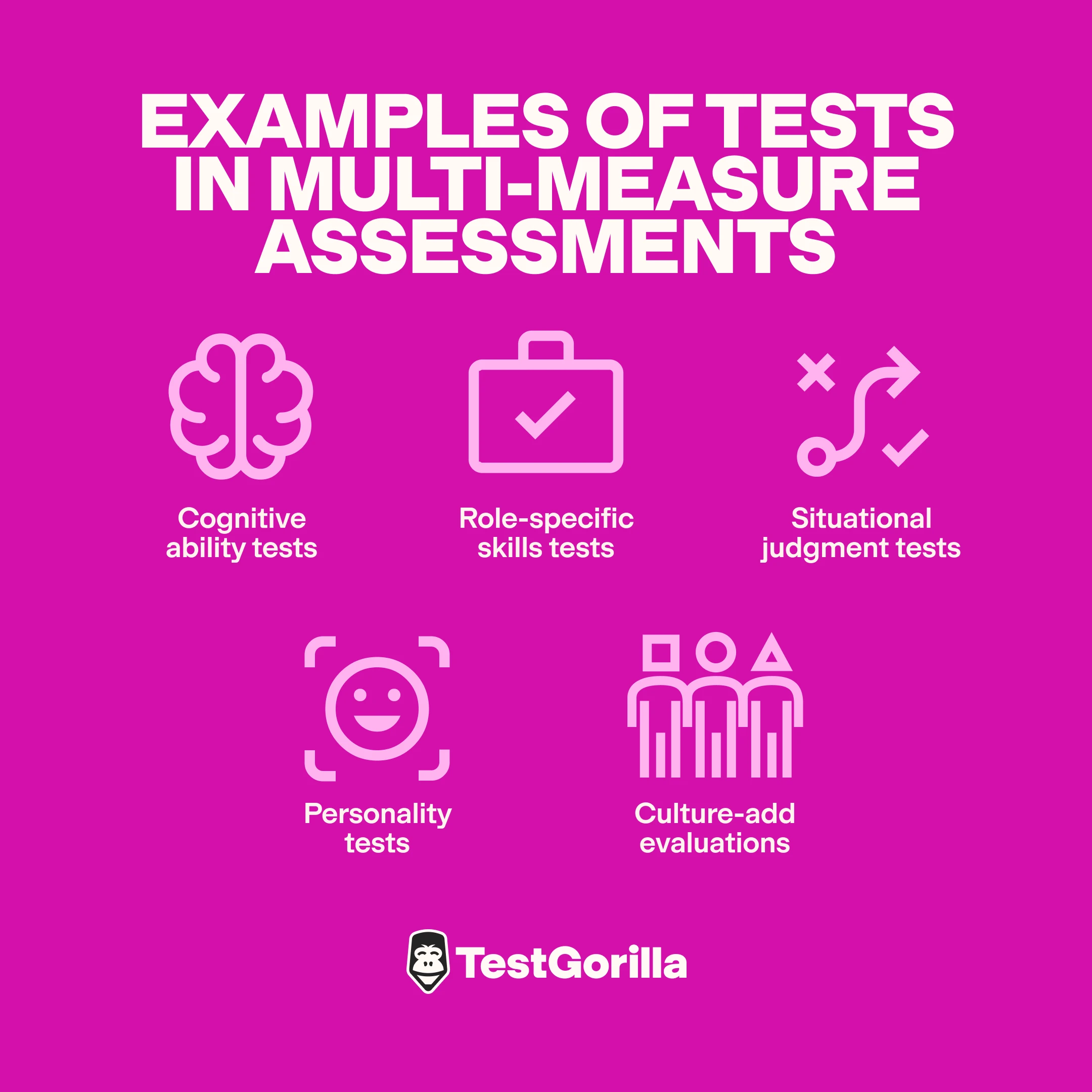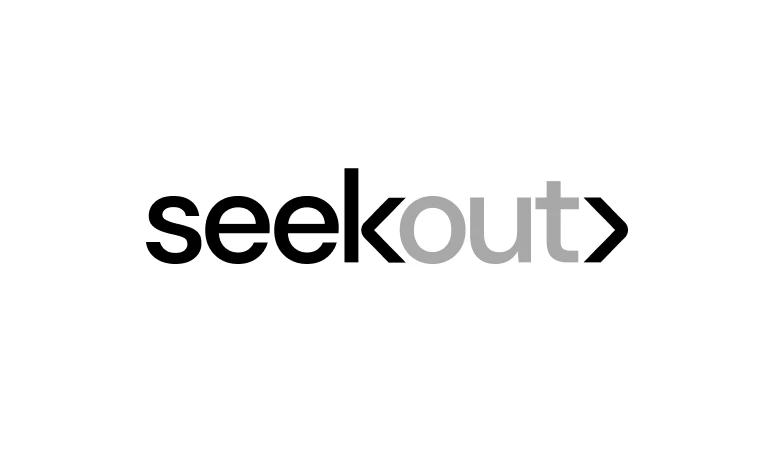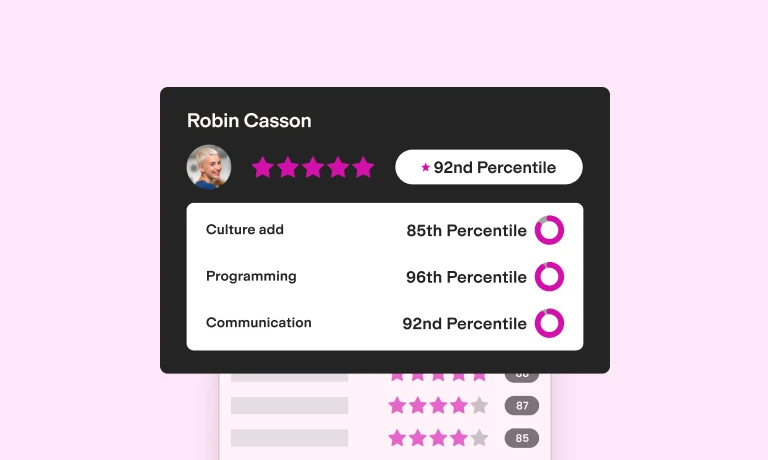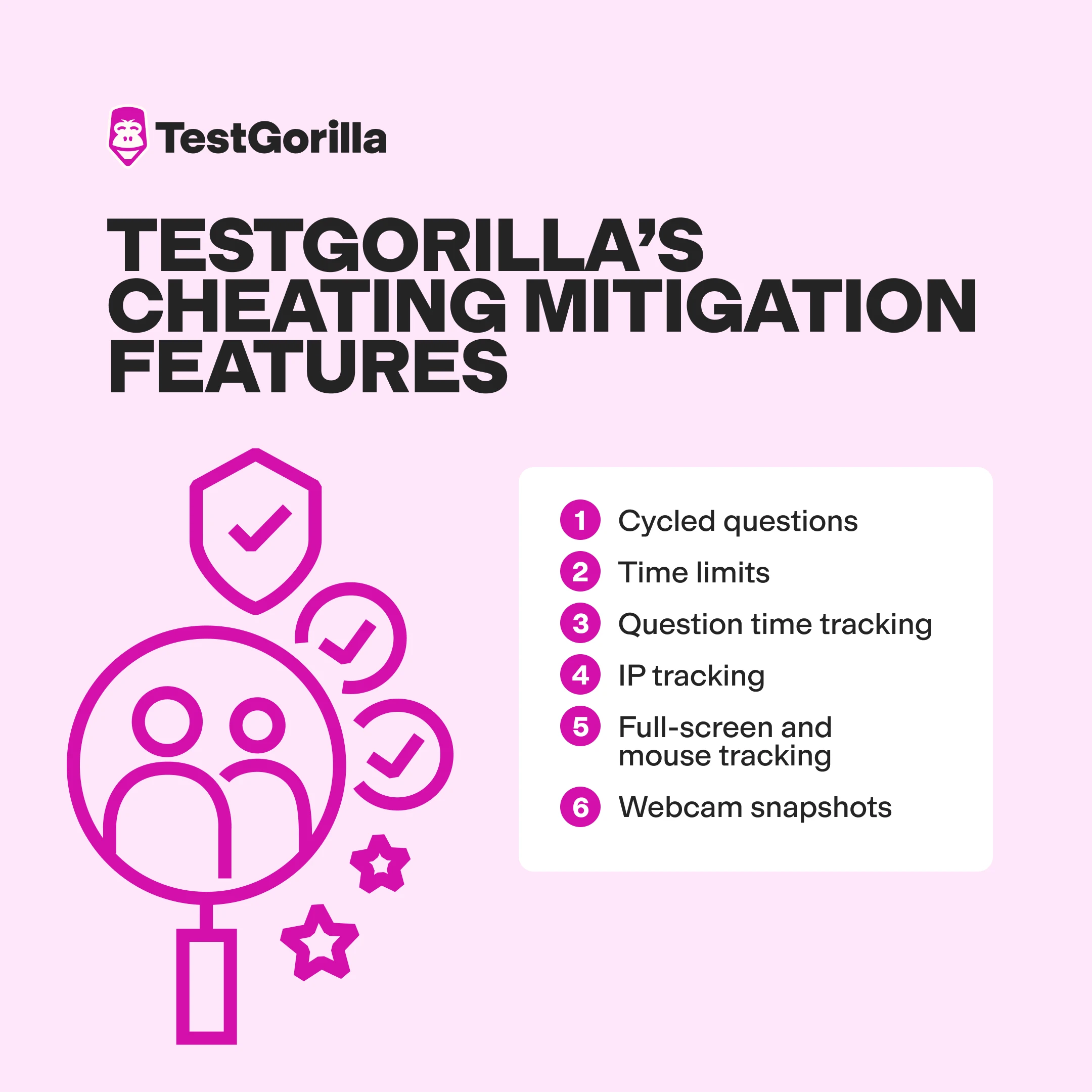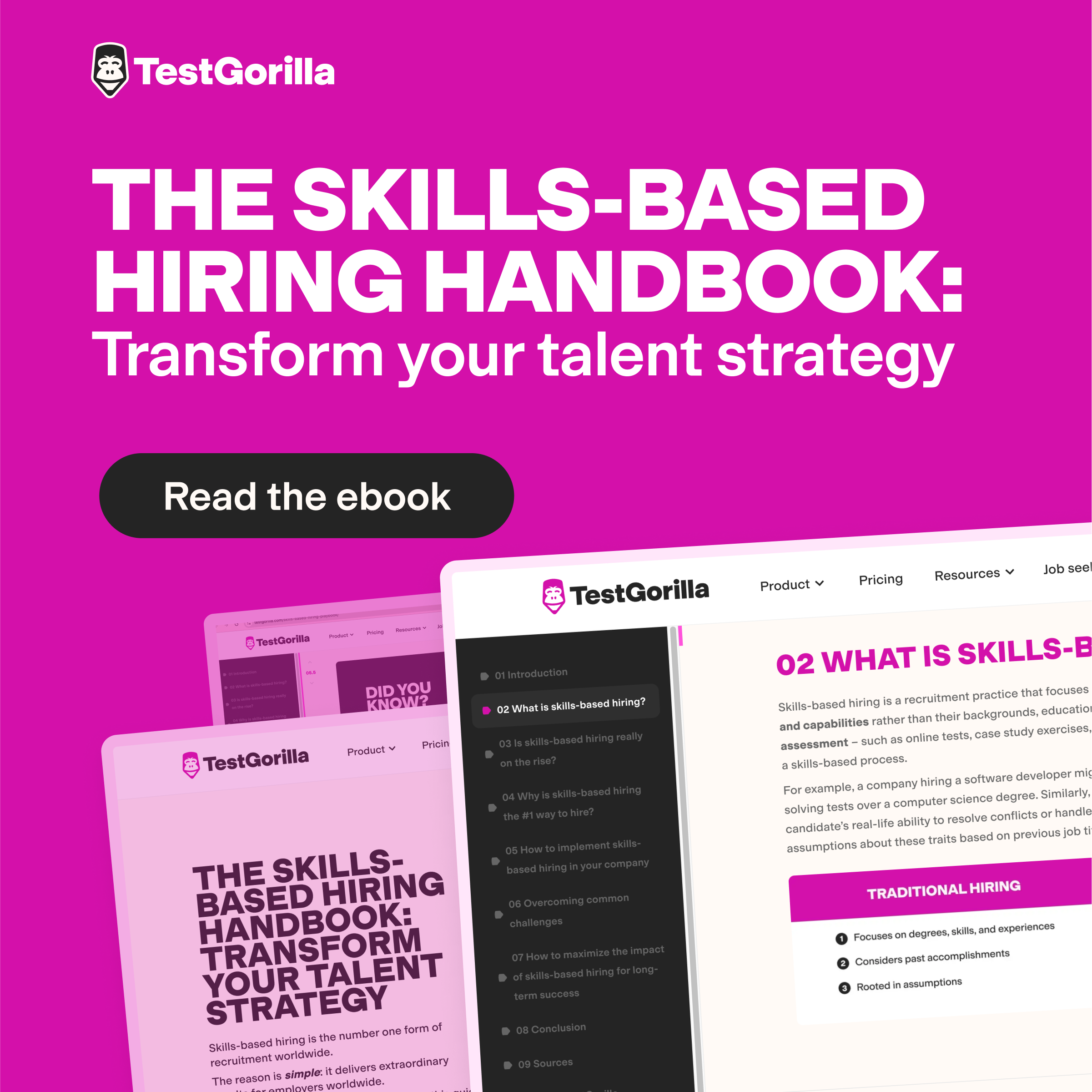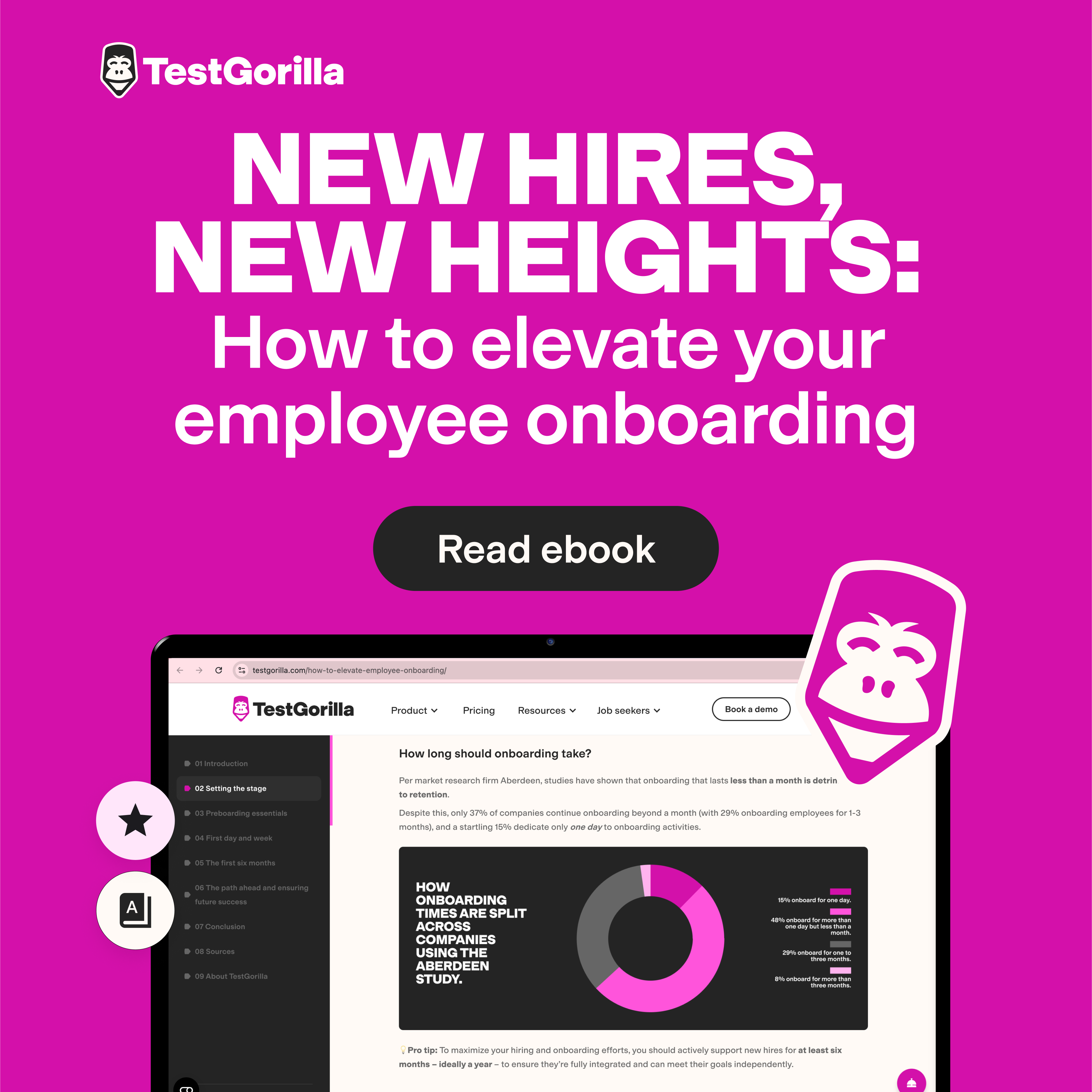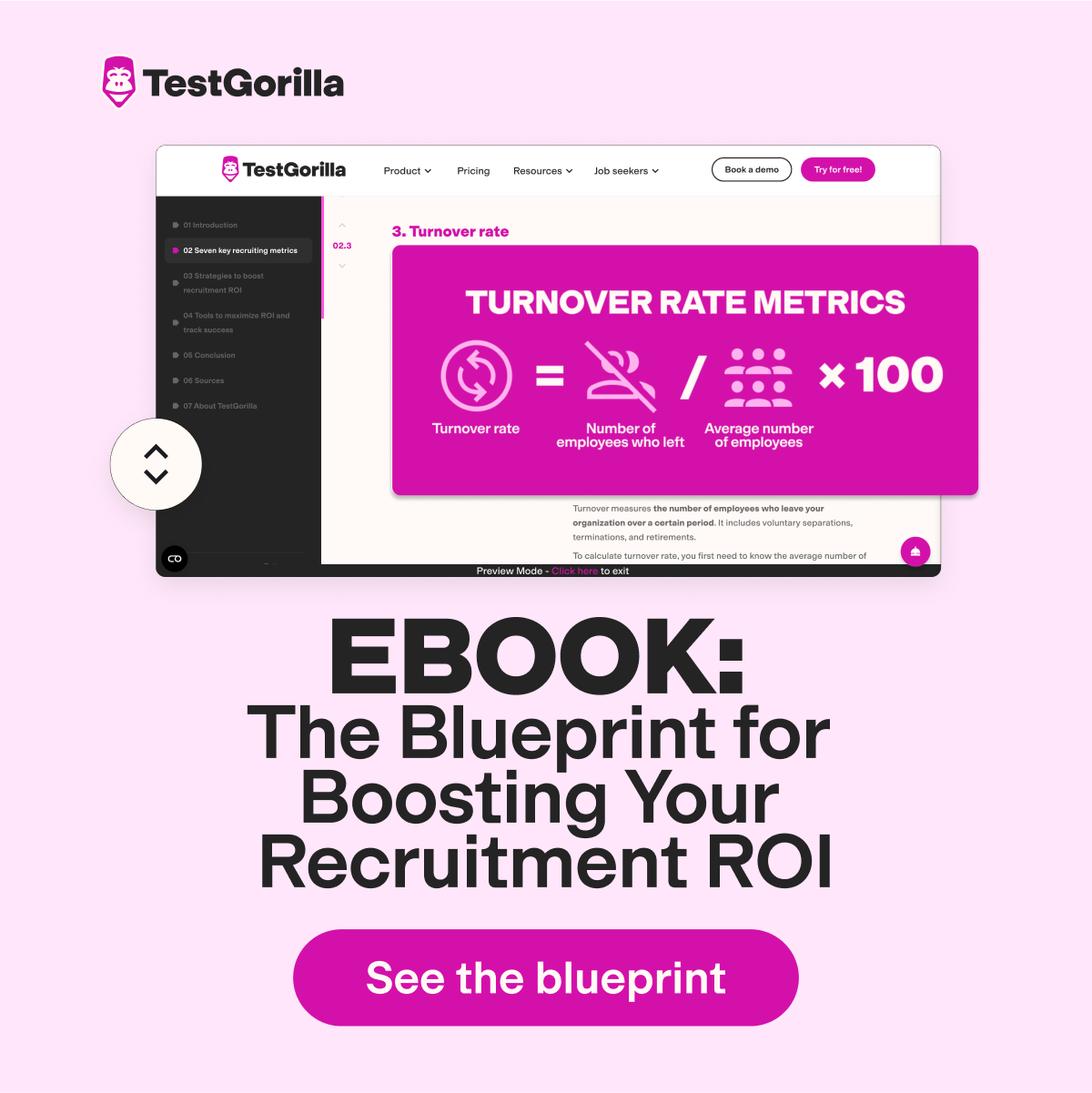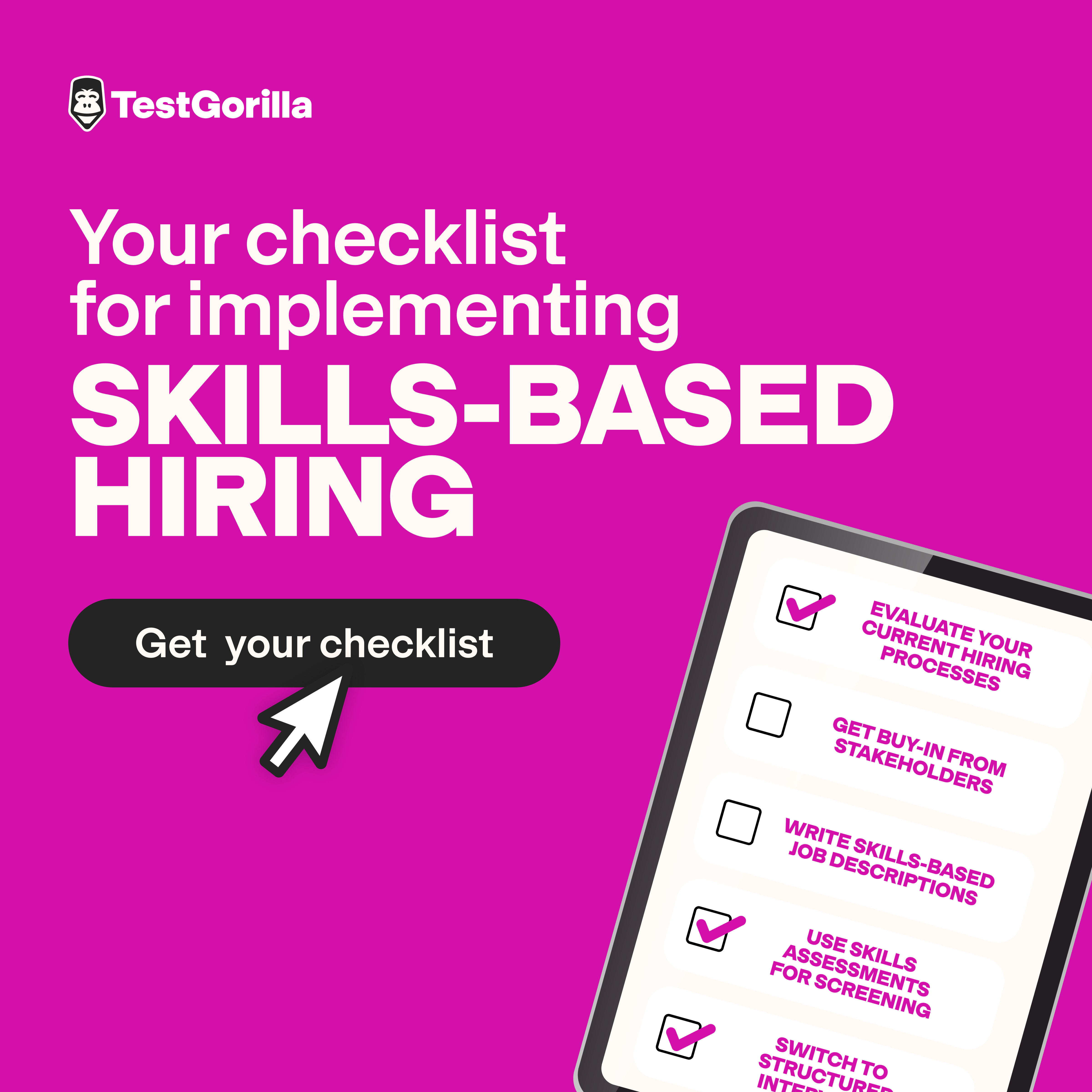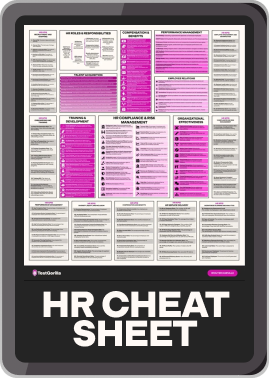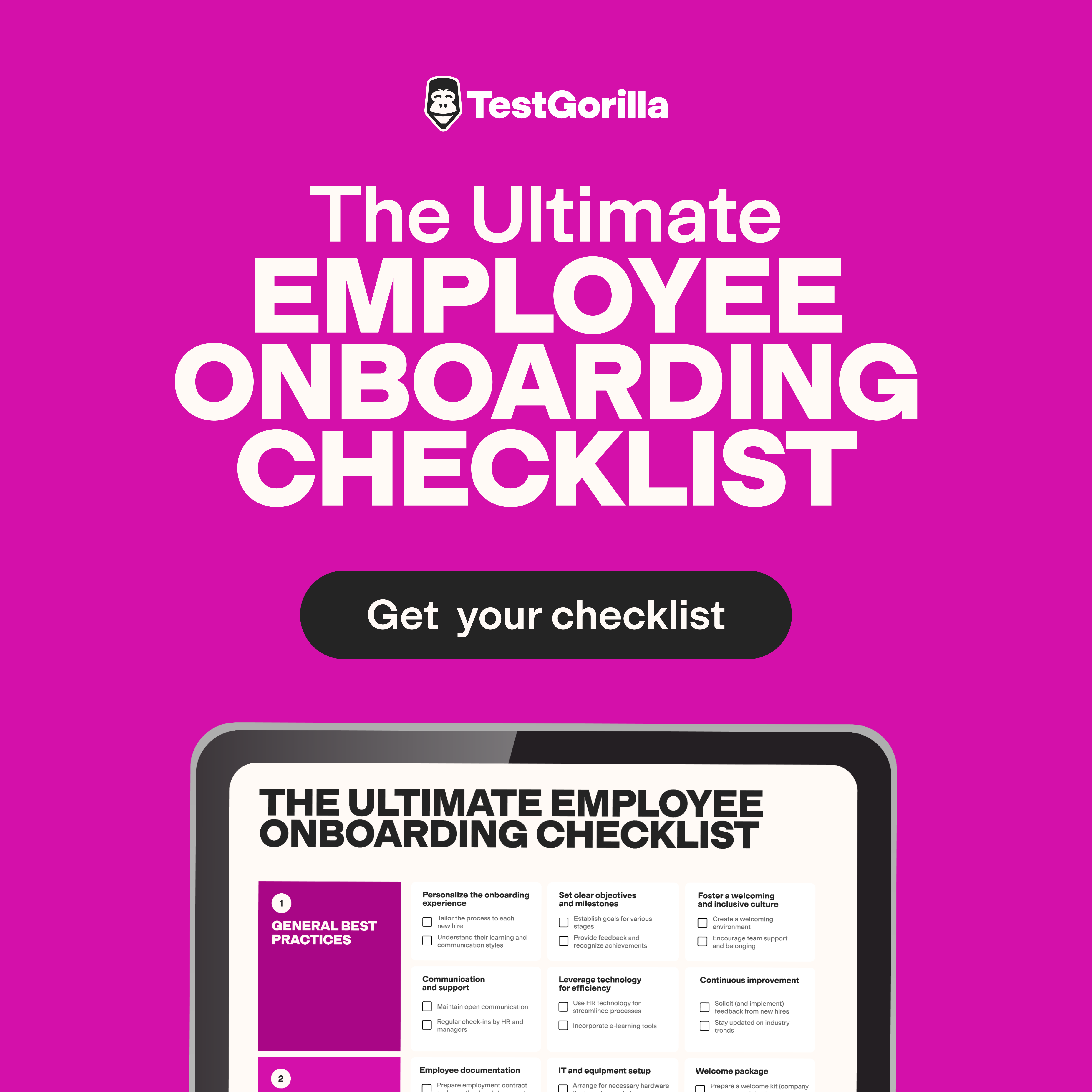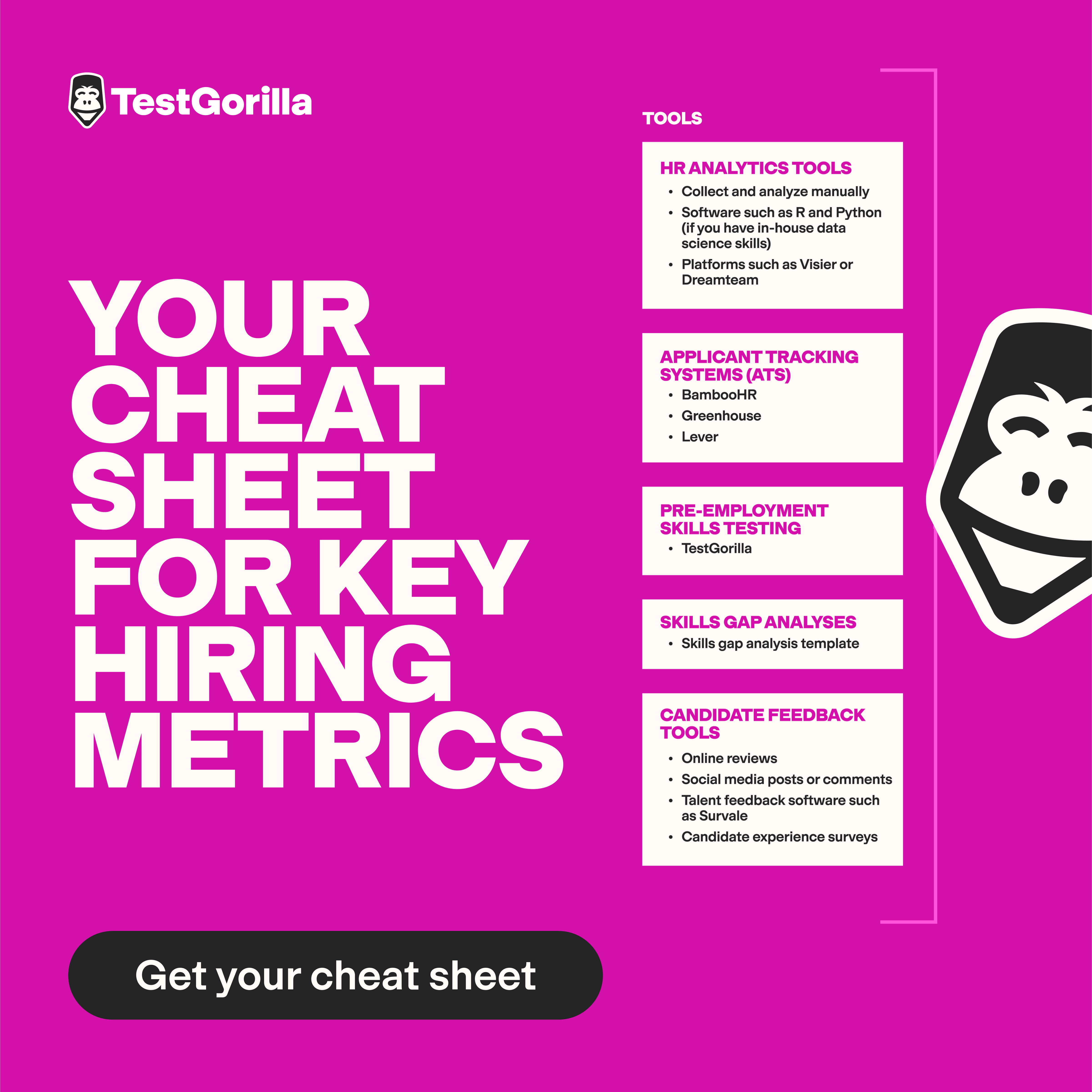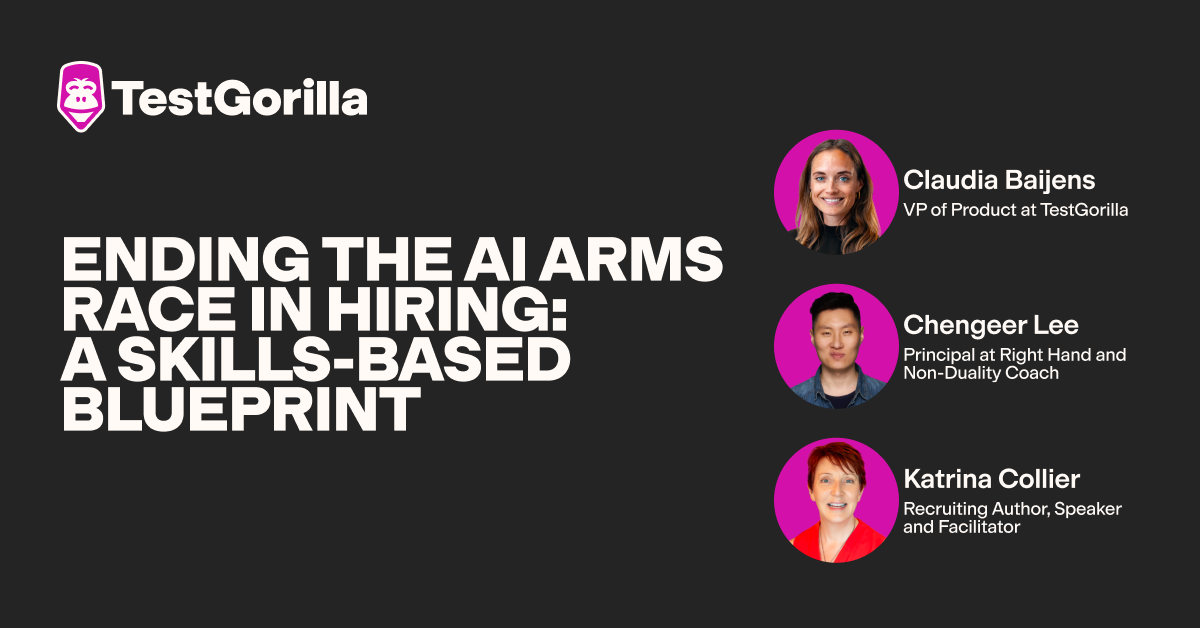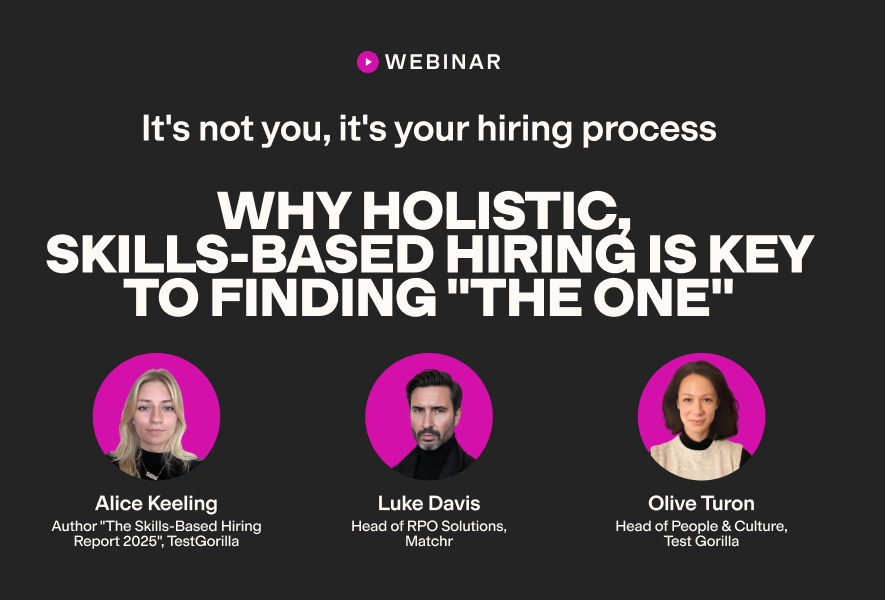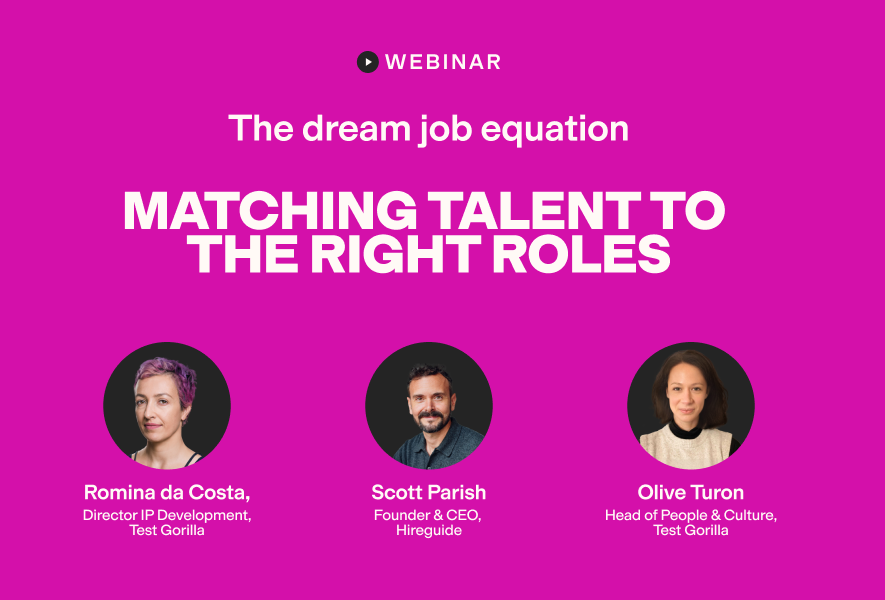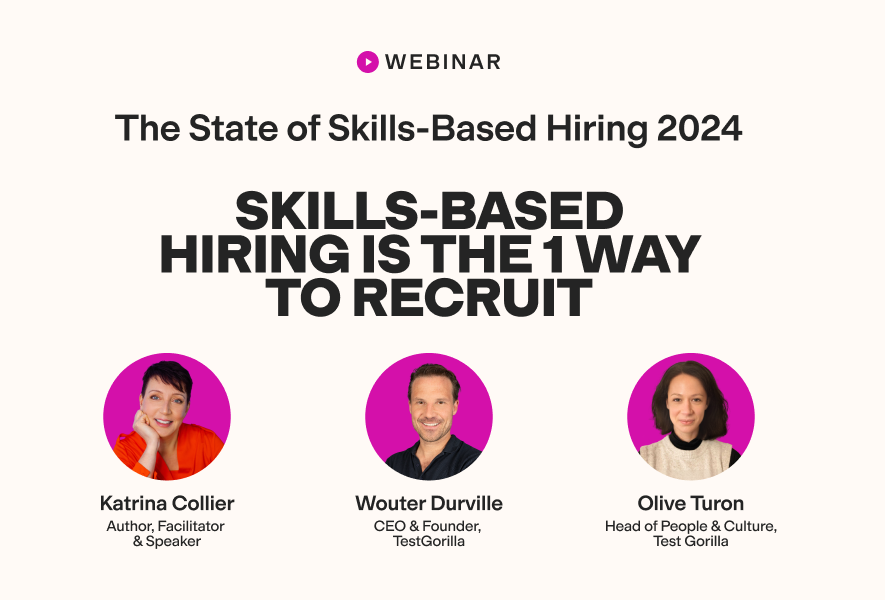Why holistic hiring with skills assessments beats over-reliance on cheating detection
Skills-based assessments can surface the most qualified candidates for the job, without human bias getting in the way. But what if you're unsure whether applicants use external help – are assessment results still valid?
These concerns are important, but that doesn’t mean talent assessment platforms' anti-cheating measures should take center stage. After all, overly intrusive anti-cheating measures can create unnecessary friction for your applicants, ultimately harming your hiring process. Meanwhile, holistic recruitment methods remain strong predictors of future job performance – even when occasional cheating occurs.
That’s why, in this article, we explain how to balance holistic, skills-based recruitment with applicant-friendly cheating detection.
Table of contents
The pitfalls of a detection-first mentality
When you implement skills-based hiring with cheating detection as a top priority, you might divert resources and attention from key elements that increase the quality of your hires and boost offer acceptance rates. You might not, for example, effectively tailor your assessment to your role, create a positive candidate experience, or build a structured, fair assessment process.
For instance, intrusive test anti-cheating methods such as remote proctoring and forced screen sharing can negatively affect the candidate experience. They increase test anxiety and disproportionately affect candidates from underrepresented backgrounds who may not have access to private or quiet test environments.
The result? False negatives – a selection error where qualified, engaged candidates abandon assessments or are wrongly flagged.
This doesn't mean it's a zero-sum game and you shouldn't consider the risk of cheating in your hiring approach. Large language model (LLM) output quality continues to get better, and applicants might resort to questionable practices (like using these models to get answers) in a competitive job market.
But even though cheating on talent assessment tests is morally ambiguous, it's unclear whether this correlates with negative job performance.
Consider this example: An open-text question asks applicants how their work experience aligns with the role’s requirements, and the candidate uses a chatbot to generate and tailor their response. This alone doesn't make them less qualified. Their answer is structured by an LLM, but the experience it details is up to scratch.
Finally, consider the return on investment (ROI) of implementing strict detection systems. Ask yourself, "What does $1 spent detecting candidate cheating bring back in increased revenue, higher productivity, or lower cost from my future hire?" Extra security measures are worthwhile only if the return is higher than $1.
Skills assessment: The key to effective hiring
The answer to effective hiring isn't either strict cheating detection or high-validity tests – but a mix of both. You want a balance between data-backed talent assessment and non-invasive monitoring to surface your most qualified candidates.
While most candidates taking skills assessments are honest, skills assessments aren't – and can't be – 100% accurate. Not only do some escape cheating detection, but a candidate’s performance can also be impacted by factors beyond their control, such as stress or interruptions.
Still, well-rounded skills assessments are strong predictors of on-the-job success. Job knowledge tests and work sample tests have similar high validity to structured interviews – that is, performance in these is highly correlated with performance in the job.
Our 2025 survey found that a significant portion of employers find skills tests predict job success more than resumes.
Meanwhile, there’s no research that shows that intensive proctoring during the hiring process correlates with high job performance. So, implementing it doesn't have any proven benefit (at least not currently).
Why are holistic skills assessments so effective?
Here’s why holistic assessments excel at reliably identifying qualified applicants compared with other assessment methods – even when they don't completely eliminate cheating.
1. They’re objective and unbiased
Talent assessments rank candidates based on their performance on scientifically validated tests. Objective, bias-free tests yield more accurate and consistent results over time – even if a handful of candidates try to game the system. In turn, this improves your quality of hire and helps you achieve diversity, equality, and inclusion (DEI) goals through hiring.
(Compare this with using interviews or resume-screening to assess abilities. Unless managed diligently, these processes can be vulnerable to bias.)
The numbers don't lie. TestGorilla research found that 82% of employers using skills-based hiring are satisfied with their recent hires – versus 67% of those not using it at all.
2. They test multiple skill sets
Combining multiple test types (AKA using “multi-measure testing”) ensures your shortlisted candidates have the knowledge and experience required for specific roles. Nine in ten employers using multi-measure assessments report high-quality hires.
But there’s a secondary benefit: Multi-faceted recruitment assessments – which often assess hard and soft skills plus values and behaviors – are harder to pass with cheating attempts. For starters, there are more points during the assessment where measures such as camera snapshots can catch cheating attempts. Also, a variety of skill and answer types, combined with time pressure, make it harder for candidates to source outside help. Finally, some questions (like personality-based questions) don’t have “right” answers.
Here are some examples of tests often included in multi-measure assessments:
Cognitive ability tests, such as problem-solving and attention to detail
Role-specific skills tests, such as financial modeling, HR management, and TikTok marketing
Situational judgment tests, such as communication and presentation skills
Personality tests, such as the Big 5 and 16 Personalities tests.
Culture-add evaluations, which let you tailor candidate questionnaires and your team's cultural profile
3. They simulate job-relevant environments
Assessments that test role-related hard skills (say, coding problems or customer service simulations) give you a taste of how candidates might approach specific problems or scenarios.
And by adding custom questions (something many assessment platforms enable you to do), you can also give test takers a sense of your team's tasks and goals while evaluating them based on what actually matters for the role.
Finally, personality and culture-fit tests help surface how someone might behave under pressure, collaborate with others, and align with your team’s values – which resumes or portfolios rarely show.
By tailoring your assessment to be wholly relevant to your open role, you can make it harder for candidates to cheat – more on this below!
That’s not all – Skills assessments are also effective because candidates prefer them
More than 80% of US candidates prefer skills-based hiring. Their top reason is that it gives them the chance to demonstrate real-world skills. So, candidate-centered skills assessments help attract and retain motivated talent – reducing long-term talent acquisition costs. However, this advantage fades if candidates feel overly monitored or distrusted during assessments.
The best insights on HR and recruitment, delivered to your inbox.
Biweekly updates. No spam. Unsubscribe any time.
TestGorilla's holistic approach: Skills at the core
TestGorilla is a talent assessment platform centered on test science. Skills come first, no exception.
Subject-matter experts design and peer-review all our tests, while test validity specialists ensure they meet high thresholds for:
Reliability: Producing consistent results across repeated uses
Content validity: Covering the relevant knowledge and skills for individual tests
Criterion-related validity: Aligning test results with real-world outcomes, such as job performance
Here at TestGorilla, we know you need to be able to trust incoming candidate results. So, we do incorporate anti-cheating measures like randomized questions, IP tracking, and time limits – supporting high-validity tests without risking candidate disengagement.
TestGorilla offers a library of 300+ tests, including cognitive ability, language, programming, and job-specific tests – making it easy to create custom holistic recruitment assessments. You can easily add custom questions to any test or even create custom tests. Together with candidate-friendly cheating prevention measures, these help employers shorten recruitment cycles and shortlist higher-quality candidates.
How to balance security and candidate experience with responsible anti-cheating measures
Online talent assessments aren't 100% cheat-proof – but they're more indicative of job performance than resumes and less bias-prone than interviews.
It’s true that live or AI proctoring (i.e., surveillance) solutions can deter applicant cheating. They are, however, costly for you and more stressful for candidates, leading to a lower ROI and suboptimal test performance.
Moving from a cheating elimination to a cheating mitigation mindset helps provide balance. How do you do this?
1. Test early
For starters, test early in the process. In the unlikely event you advance a candidate who cheated, their role suitability becomes apparent in their responses to interview questions, such as scenario-based or behavioral ones.
2. Include difficult-to-cheat-on custom questions
You can make your custom questions and tests harder to cheat on by providing visuals like graphs and diagrams, and asking test-takers to explain their thought processes.
You can further prevent cheating-by-chatbot with a few tricks. First, ask candidates to use role- or industry-specific knowledge that is hard to come by publicly. Second, include contradicting or irrelevant information in custom scenarios. And third, ask "How did you reach that conclusion" follow-ups.
These strategies weaken cheating attempts because LLMs usually:
Can't access specialist information or data points
Take information at face value and don't assume it's wrong or irrelevant
Don't reliably explain how they reached previous outputs
3. Use cheating mitigation features (but use them responsibly)
Your talent assessment platform's cheating mitigation features can lend a hand. For instance, TestGorilla provides:
Cycled questions: Randomizes questions and their order out of the test's question pool
Time limits: Ends tests automatically at set times, preventing external research
Question time tracking: Tracks answer time per question and highlights anomalies (such as very quick answers)
IP tracking: Identifies multiple attempts from the same IP address, which can indicate impersonation or test-sharing
Full-screen and mouse tracking: Flags if candidates leave the assessment's full-screen mode, or if their mouse cursor strays from the assessment.
Webcam snapshots: Capture images every 30 seconds using the candidate's device camera to prevent and monitor outside help
You should also use anti-cheating data, such as webcam snaps, responsibly. Prioritize candidate privacy and trust. For example, inform candidates that images may be collected through their device cameras and explain why. When storing and viewing candidate data, such as images, follow applicable regional laws and regulations – such as the California Consumer Privacy Act and the EU's General Data Protection Regulation (GDPR).
Also, be aware that TestGorilla's anti-cheating measures flag anomalies – they don't determine guilt. Treat flags as starting points for follow-up, not instant disqualifiers, since mistakes and technical issues (like out-of-window incoming calls) do happen.
Communicate respectfully with candidates where there are question marks (and high-ranking scores). For example, reach out to ask about flagged behavior, explain what was detected, and suggest a follow-up conversation or retest.
Hire holistically while mitigating cheating with TestGorilla
If you must choose between detection-first mediocre skills tests and evidence-backed assessments with non-intrusive cheating measures – choose the latter. Holistic hiring methods, including high-validity tests and structured interviews, are strong indicators of job success and boost the quality of your hires.
Plus, by using multi-measure tests and custom questions tailored to your role, you're making it even harder for applicants to use external help. TestGorilla prioritizes science-first, candidate-friendly assessments and offers 400+ tests across cognitive ability, job-related, personality, culture, and other test types.
It also provides robust anti-cheating tools, including full-screen tracking and webcam snapshots, which you can monitor and follow up on, for a fair, respectful recruitment process.
Get started with TestGorilla on a free account today.
You've scrolled this far
Why not try TestGorilla for free, and see what happens when you put skills first.


